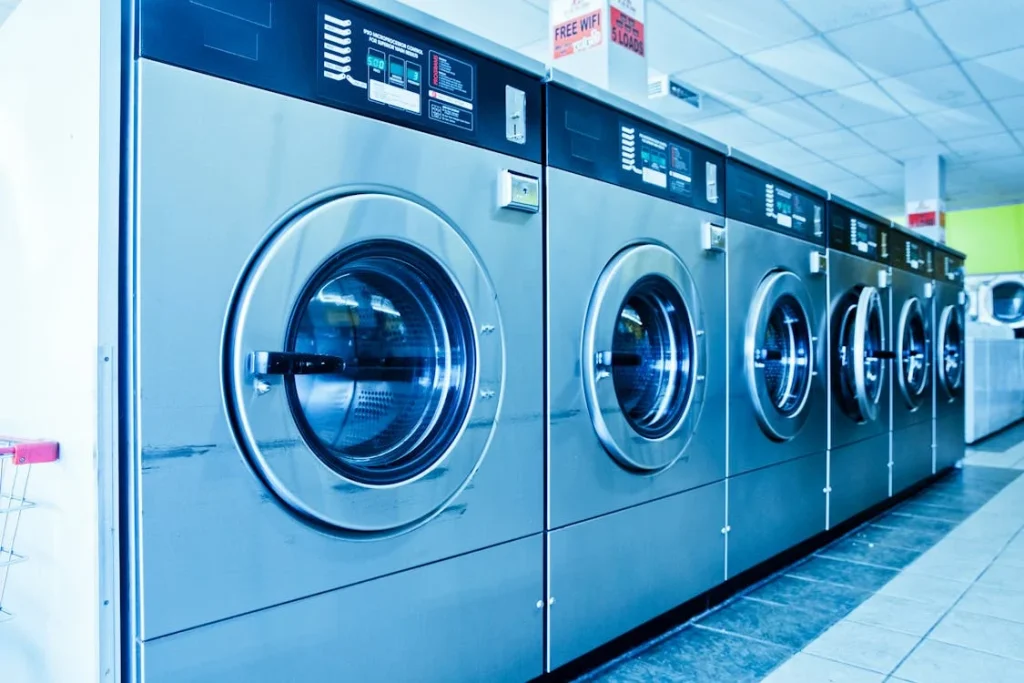Industrial wash extractors are vital for laundries, ensuring efficiency and cost savings. But without proper maintenance, their lifespan of wash extractors shortens, leading to costly repairs. Want to keep yours running smoothly for years? Follow these expert tips to avoid common mistakes and maximize your machine’s performance.
Table of Contents
- 1. Understanding Your Wash Extractor
- 2. The Importance of Proper Maintenance
- 3. Daily Maintenance Tips for Longevity
- 4. Weekly and Monthly Maintenance Routines
- 5. Avoiding Costly Repairs with Preventive Care
- 6. Professional Servicing: When and Why?
- 7. Smart Usage Practices to Reduce Wear and Tear
- 8. Conclusion: Maximize the Life of Your Wash Extractor
- 9. FAQs
For high-quality industrial laundry solutions, visit Spin Washing and check out their industrial laundry equipment.
1. Understanding Your Wash Extractor

A wash extractor plays a crucial role in industrial laundry operations, handling large loads while maintaining cleaning efficiency. Understanding how it functions and its key components will help ensure long-term performance.
1.1. How a Wash Extractor Works
A wash extractor combines washing and high-speed water extraction. The inner drum rotates, using programmed cycles, detergent injections, and precise water levels to remove dirt. After washing, the high-speed spin cycle extracts excess moisture, reducing drying time and energy costs. Proper care ensures the machine remains efficient and effective.
1.2. Key Components and Their Functions
- Inner & Outer Drums – Hold and rotate laundry during cycles.
- Motor & Bearings – Drive the drum’s movement.
- Drain Valve & Pumps – Control water removal.
- Control Panel & Sensors – Manage cycle settings and safety.
- Seals & Hoses – Prevent leaks and direct water flow.
Knowing how each part functions helps identify early signs of wear and avoid costly breakdowns.
2. The Importance of Proper Maintenance
Neglecting maintenance leads to breakdowns, increased energy consumption, and expensive repairs. A well-maintained extractor ensures smooth operation, lower costs, and prolonged service life.
2.1. Why Regular Maintenance Matters
Routine maintenance prevents small issues from becoming major problems. Clogged drains, overworked motors, and damaged bearings often result from poor upkeep. Regular inspections and cleaning keep your extractor in peak condition, reducing downtime and extending its operational lifespan. A proactive approach saves money in the long run.
2.2. Common Mistakes That Reduce Lifespan
Many laundries make simple yet damaging mistakes. Overloading puts excessive strain on the motor, while underloading wastes energy. Using the wrong detergents causes corrosion. Ignoring small leaks leads to major water damage. Skipping regular inspections increases wear on parts. Avoid these errors to keep your machine running efficiently.
3. Daily Maintenance Tips for Longevity
Daily upkeep prevents gradual damage, reducing repair costs and improving machine performance. Follow these simple but effective practices to protect your wash extractor.
3.1. Proper Loading Techniques
Overloading strains internal components, increasing wear on bearings and motors. Underloading wastes water and energy. Always follow the manufacturer’s recommended load capacity. Evenly distribute laundry inside the drum to prevent imbalanced spinning, which causes excessive vibration and stress on the machine’s frame.
3.2. Checking and Cleaning Filters
Clogged filters reduce drainage efficiency, causing water buildup inside the drum. Clean filters daily to prevent lint, debris, and detergent residues from accumulating. A blocked filter forces the pump to work harder, increasing energy consumption and reducing the machine’s overall efficiency. Keeping it clean ensures optimal performance.
3.3. Using the Right Detergents and Chemicals
Harsh chemicals corrode machine parts over time, leading to leaks and damage. Always use detergents designed for industrial machines. Low-foaming, biodegradable detergents work best, preventing residue buildup while protecting internal components. Following manufacturer recommendations for chemical use extends the machine’s lifespan and enhances cleaning efficiency.
3.4. Inspecting Seals and Hoses for Wear and Tear
Leaks can cause significant damage if ignored. Check rubber seals and hoses daily for cracks, stiffness, or small leaks. Replace worn parts immediately to prevent water damage. A small leak today can turn into a costly repair tomorrow. Proactive monitoring ensures smooth operation and prevents major malfunctions.
4. Weekly and Monthly Maintenance Routines
Deeper maintenance routines prevent mechanical failure, improve performance, and help detect early warning signs. Setting aside time for thorough inspections is key.
4.1. Lubricating Bearings and Moving Parts
Lubrication minimizes friction, reducing wear on essential components. Apply manufacturer-recommended lubricants to bearings, hinges, and other moving parts. Lack of lubrication leads to overheating and breakdowns, shortening the machine’s lifespan. Regular lubrication ensures smooth operation and prevents costly replacements.
4.2. Deep Cleaning the Drum and Housing
Soap scum, lint, and mineral deposits accumulate inside the drum, reducing efficiency. Once a month, run a hot water cycle with a descaling agent to remove residue. Wipe down the machine’s exterior and inner drum to prevent rust and bacterial growth. A clean machine operates more efficiently.
4.3. Examining Electrical Connections and Controls
Loose wires and corroded connectors lead to operational failures. Inspect control panels, wiring, and switches monthly. Tighten any loose connections and clean terminals to prevent power fluctuations. Ensuring proper electrical function reduces safety risks and prevents unexpected breakdowns.
5. Avoiding Costly Repairs with Preventive Care
Preventive maintenance saves money, extends machine life, and reduces unexpected downtime. Identifying potential issues early is crucial.
5.1. Identifying Early Warning Signs of Damage
Unusual noises, vibrations, or slow drainage indicate potential problems. If cycles take longer than usual or you notice excessive water retention, check components immediately. Addressing minor issues early prevents major breakdowns, reducing repair expenses and keeping your machine running smoothly.
5.2. Keeping Drainage Systems Clear
A blocked drain increases drying time and strains the pump. Regularly clear lint traps and inspect drainage hoses for buildup. Running a vinegar rinse monthly dissolves mineral deposits, maintaining proper water flow. Clean drainage systems prevent flooding and operational inefficiencies.
5.3. Maintaining Proper Water Levels and Temperature
Incorrect water levels cause improper washing, while extreme temperatures wear out internal parts. Monitor and adjust settings according to laundry requirements. Keeping water at optimal levels prevents unnecessary strain on the motor and heating elements, enhancing long-term performance.
6. Professional Servicing: When and Why?
Regular professional inspections detect hidden issues and optimize machine performance. Knowing when to schedule servicing helps prevent costly failures.
6.1. The Role of Professional Inspections
Certified technicians identify problems before they escalate. From motor performance to water pressure regulation, professional assessments ensure all components function correctly. Scheduling inspections prevents major breakdowns and keeps your machine in peak condition.
6.2. How Often Should You Schedule Maintenance?
For high-usage machines, professional servicing every six months is ideal. Lower-volume operations may require annual inspections. Consistent maintenance extends equipment lifespan, reduces repairs, and improves efficiency. Don’t wait for failures—schedule routine servicing to protect your investment.
6.3. Choosing the Right Service Provider
Select a service provider specializing in industrial laundry machines. Experienced technicians offer tailored maintenance solutions. Need expert servicing? Contact Spin Washing for reliable support.
7. Smart Usage Practices to Reduce Wear and Tear
Usage habits significantly impact machine longevity. Implementing best practices minimizes wear and ensures smooth operation.
7.1. Avoiding Overloading and Underloading
Excessive loads put strain on the motor and bearings, while small loads waste resources. Balance load sizes to optimize efficiency. Following weight recommendations prevents mechanical stress, ensuring consistent performance and long-term durability.
7.2. Energy Efficiency and Water Conservation Tips
Using eco-friendly detergents, adjusting water levels, and running full loads reduces energy and water waste. Selecting energy-efficient cycles optimizes performance while cutting costs. Conservation efforts not only extend machine life but also improve operational sustainability.
8. Conclusion: Maximize the Life of Your Wash Extractor
With proper care, a wash extractor can last over a decade. Regular maintenance, preventive care, and smart usage practices make all the difference. Protect your investment by following these expert tips.
For durable, high-performance industrial washing solutions, visit Spin Washing. Need professional guidance? Contact us at Spin Washing.
9. FAQs
1. How often should I clean my wash extractor’s filter?
Clean it daily to prevent blockages and maintain proper drainage.
2. What is the best detergent for industrial wash extractors?
Use industrial-grade, low-foaming detergents to protect machine components.
3. How do I know if my wash extractor needs servicing?
Unusual noises, leaks, or longer cycles indicate the need for maintenance.
4. Can I use regular lubricants for machine bearings?
No, always use manufacturer-approved lubricants to prevent damage.
5. What is the average lifespan of an industrial wash extractor?
With proper maintenance, it can last 10–15 years or longer.
Here are some other articles that we think might interest you:
Top 6 Brands of Industrial Washing Machines


